The A. H. Church Collection of Japanese Sword-Guards (Tsuba)
An unpublished catalogue of the A. H. Church collection of Japanese sword-guards (tsuba) by Albert James Koop.
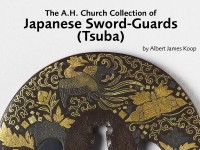
The incrustation in these two types of guard differs from that of the preceding groups in the methods by which it is secured to the iron ground.
Gomoku-zōgan, “rubbish incrustation”, aptly describes a very peculiar technique in which the iron ground is largely covered with snippets of fine wire (brass, copper, or rarely silver) spread in irregular groups and brazed or soldered in place, the whole being finally polished flat. The resulting designs inevitably recall the debris of twigs and pine-needles seen floating on mountain-pools. A common variety has small brass badges distributed among the gomoku. Another, using shorter snippets gathered in raised groups and not polished flat, imitates “stick-lac”, i.e. twigs covered with lac, the resinous incrustation caused by the lac-insect
Mukade-zōgan, “centipede incrustation”, with equal appropriateness describes a technique in which a wire (usually of iron) following the outline of the guard is held down by numerous little staples of iron or brass wire having their ends let into the iron ground. A variety displays portions only of this “centipede” ring.
Guards of both types are unsigned and their place of origin is uncertain, though they can confidently be dated to the 17th and 18th centuries.
Gomoku guards
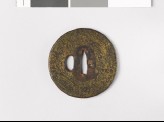 Tsuba incrusted with brass wire (EAX.10172)
Tsuba incrusted with brass wire (EAX.10172)
 Tsuba in the form of a mitsudomoye, or three-comma shape (EAX.10173)
Tsuba in the form of a mitsudomoye, or three-comma shape (EAX.10173)
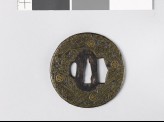 Round tsuba incrusted with brass wire (EAX.10174)
Round tsuba incrusted with brass wire (EAX.10174)
 Tsuba with 'stick-lac' decoration (EAX.10175)
Tsuba with 'stick-lac' decoration (EAX.10175)
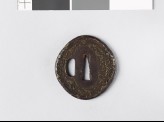 Tsuba with 'stick-lac' decoration (EAX.10176)
Tsuba with 'stick-lac' decoration (EAX.10176)
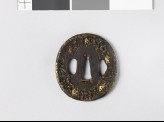 Tsuba with 'stick-lac' decoration and monkeys amid rocks (EAX.10177)
Tsuba with 'stick-lac' decoration and monkeys amid rocks (EAX.10177)
Mukade guards
Notice
Object information may not accurately reflect the actual contents of the original publication, since our online objects contain current information held in our collections database. Click on 'buy this publication' to purchase printed versions of our online publications, where available, or contact the Jameel Study Centre to arrange access to books on our collections that are now out of print.
© 2013 University of Oxford - Ashmolean Museum


